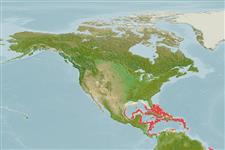>
Ovalentaria/misc (Various families in series Ovalentaria) >
Opistognathidae (Jawfishes)
Etymology: Opistognathus: Greek, opisthe = behind + Greek, gnathos = jaw (Ref. 45335); to the very elongate upper jaw of the type species of the genus, Opistognathus nigromarginatus (Ref. 128653); leprocarus: From the Greek 'lepros' meaning scaly and 'kara' meaning head, in reference to the well developed cephalic squamation (Ref. 26893).
Environment: milieu / climate zone / depth range / distribution range
Ecologia
marinhas batidemersal; intervalo de profundidade 165 - 308 m (Ref. 26893). Deep-water
Western Central Atlantic: known only from the Bahamas and the Lesser Antilles, including Anegada Passage, between Virgin Islands and Anguilla (ANSP 138563).
Tamanho / Peso / Idade
Maturity: Lm ? range ? - ? cm
Max length : 8.1 cm SL macho/indeterminado; (Ref. 26893)
Espinhos dorsais (total) : 10 - 11; Raios dorsais (total) : 11 - 13; Espinhos anais: 3; Raios anais : 11 - 12; Vértebras: 26. Anterior nostril a short tube without cirrus on posterior rim; posterior end of maxilla rigid, without thin flexible lamina; opercle with prominent wedge-shaped dark blotch; buccal cavity and inner lining of maxilla and adjacent membranes immaculate; dorsal fin spines slender, straight, with rigid sharp tip; nape completely scaled; cheeks with 4 or 5 rows of scales; segmented anal fin rays 11 or 12; caudal vertebrae 16; pelvic fins elongate in adults 39-49% SL with tip of depressed fin extending posteriorly well past anal fin origin (Ref. 26893).
Observed using shells and rubble to close their burrow opening (Ref. 26893).
Ciclo de vida ou comportamento de acasalamento
Maturities | Reprodução | Spawnings | Egg(s) | Fecundities | Larvas
Smith-Vaniz, W.F., 1997. Five new species of jawfishes (Opistognathus: Opistognathidae) from the western Atlantic ocean. Bull. Mar. Sci. 60(3):1074-1128. (Ref. 26893)
Status na Lista Vermelha da UICN (Ref. 130435)
Ameaça para os humanos
Harmless
Uso pelos humanos
Ferramentas
Relatórios especiais
Baixar XML
Fontes da internet
Estimates based on models
Preferred temperature (Ref.
123201): 14 - 22.7, mean 19 °C (based on 16 cells).
Índice de diversidade filogenética (Ref.
82804): PD
50 = 0.5000 [Uniqueness, from 0.5 = low to 2.0 = high].
Bayesian length-weight: a=0.00389 (0.00180 - 0.00842), b=3.12 (2.94 - 3.30), in cm total length, based on all LWR estimates for this body shape (Ref.
93245).
Nível Trófico (Ref.
69278): 3.4 ±0.6 se; based on size and trophs of closest relatives
Fishing Vulnerability (Ref.
59153): Low vulnerability (10 of 100).
